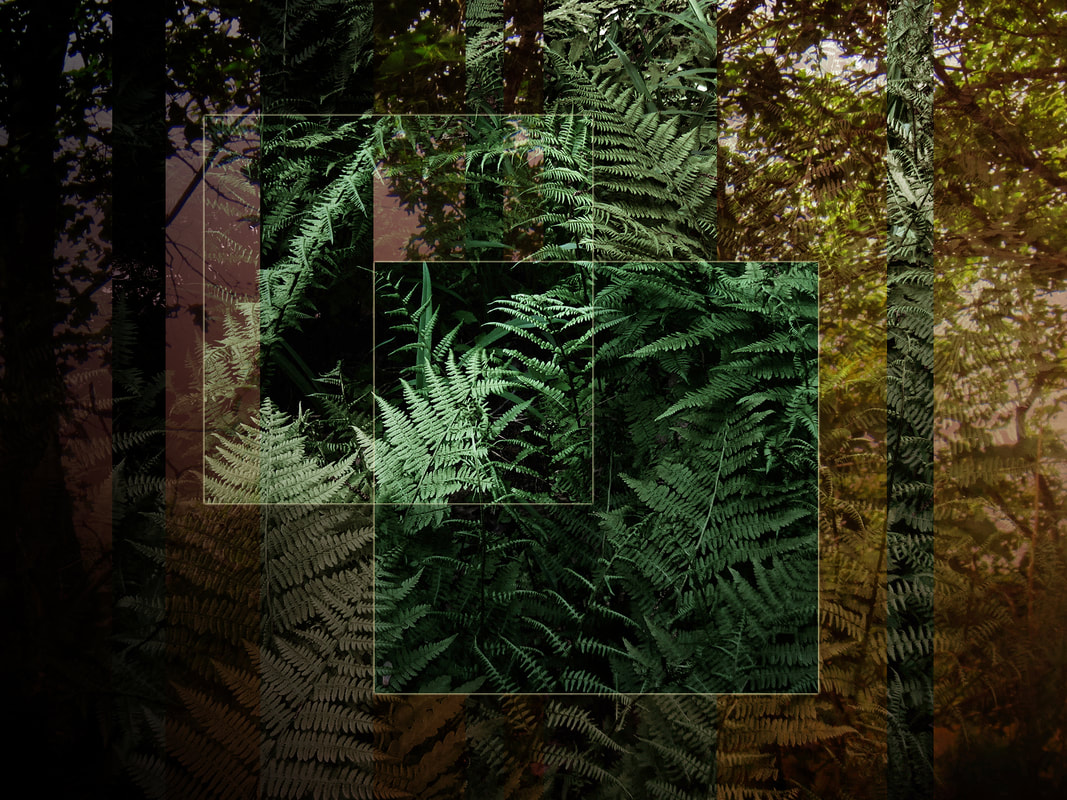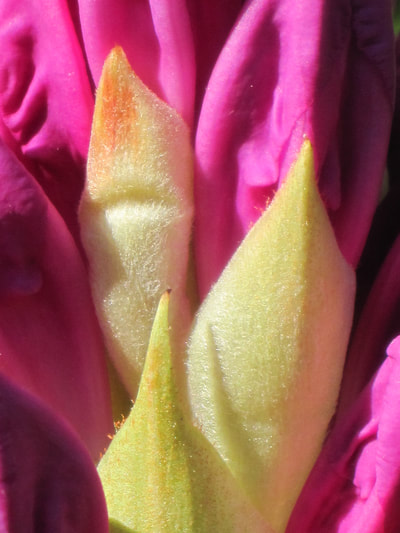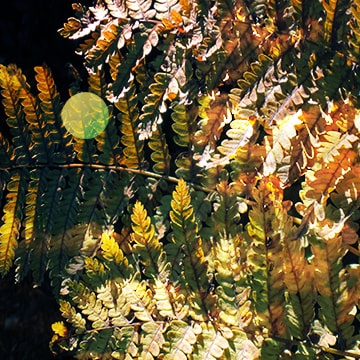| Recently, I have been immersed in exploring abstraction in photography as intervened upon with digital art. Digital photo collage is precisely like traditional collage except it makes use of digital tools located in such computer software programs as Photoshop. The scissors are traded in for a mouse which enables one to select a cutting tool; this latter is then used to manually trace around the form one wishes to clip. To paste a shape you simply must set the figure into the wanted position. Thus, the computer is being guided by the hand directly to complete the work the artist has imagined with his or her mind's eye. In the work to the right, "Iris Meditation", traditional photography is combined with digital, art making. The work began with a photograph of the interior of a French iris. This photograph provided the basis for the subsequent abstract interventions. Geometric forms were then drawn onto the black and white, iris image with the aforementioned software's shape tools. Shapes were then hand colored and hand positioned. It is a falsity to believe that digitally created or influenced art is less in value or work input than the traditional media based, art pieces. One must forgo ones' preconceptions. The computer and the software are merely tools to achieve an artistic end. As any tool the computer requires the artist's forethought and manual dexterity. Digital art is merely the new frontier. Let us embrace the computer as a tool which enables the creative spirit to mold fresh and interesting worlds. |
|
0 Comments
The work below, "Magenta Halo", results a marriage of two distinct media - traditional drawing and digital painting. As in all "techspressionism" pieces, the artist makes use of computer technology to produce visually bold work which wishes to elicit a spontaneous, emotional response. In the noted piece, vivid yellows contrast with flourescent pinks to create a pulsating image . . . hues blending and separating appear to vibrate. Inspired by 50s color field painting, "Magenta Halo" evokes feelings simultaneously of contemplation and euphoria. Making use of artistic color theory, here, the painter has complimented a purplish pink with a lemony tone . . . each of these colors is the others opposite on the color wheel. Thus, a "high tone" is evoked between the melding of the two hues. To learn more of the contemporary movement "Techspressionism", please visit www.techspressionism.com. In the work above, "Here and There", this artist is seeking to resolve formal, as well as symbolic
challenges. In the series to which the noted piece belongs, Intimacies, one wishes to reveal the cryptic nature of isolated or secluded places within untouched settings. "Here and There" is composed of several scenes melded in such a way that the viewer is induced to believe he or she is lost within the thick of the woods - in a "bramble" of ferns, maples and other deciduos trees. What one is meant to feel is urged into the lush character of a previously unexplored place. The ferns, encased in boxes of light, are as lenses - giving us a look into the dense foliage of the forest's usually unnoticed floor. The emerald green foliage of the ferns is contrasted with the olive green and sage of the neighboring flora. The all is meant to coax the observer into examining the piece in question carefully. There is more than meets the eye in this bit of the woods full of hidden meanings. What is life without Art? Empty? Lacking in enthusiasm? -
Life without art is quite obviously dull and colorless. Bland is the world denied the rainbow of shades produced by the visual arts. Why should one care? Imagine a book without pictures - what would children read . . . how would they imagine? Art IS, as said, the color of life. Paintings, sculpture, all genre of art tells of existence . . . of personal, as well as, universal hopes, dreams and ambitions, etc. The visual arts grant vision to an often directionless society. Think of a framed photograph. Why should one invest in its acquisition? Well, BEAUTY nourishes the soul. It grants an instant high, a pleasure response, that is deep and sincerely felt. Nothing can replace that lasting serene and euphoric memory. And . . . what is memory? Tis but images seen, enjoyed and catalogued in your heart and mind's repository. Art is pleasure. Art is protest. Art IS a visual statement. One can read a piece of art a million times and garner a thousand different meanings. Art is mood. It is a chameleon constantly altering in its impression - as the sensitivity or emotions of the viewer shift so does a creative piece's interpretation. Art is then psychology, science and beauty. It touches all we are, everything we encounter with its vibrancy of language. In addition, there is no right answer to choosing or appreciating a visual piece. If you love it, then you have spoken with it; you have conversed with the essence of the artist. The best to you, therefore, when you voyage through a museum. May you come upon many lands and perhaps stand awhile and pitch a tent. For Art is an adventure - art is life. What is different in art and in life in general should not be
discouraging . . . rather, it should be inspirational. The things one sees in our travels and naturally in our environment are meant to be discovered, somehow understood. When one comes upon an object or piece of art that is different, unconventional, even "ugly or unpleasant", the reaction should not be of disdain but rather of questioning. Why does one dislike something or ignore it because it is out of our ordinary experience or collective memory??? The introduction to it, our coming upon it, may be sour . . . not pleasurable because it does not meet our standards of beauty or does not communicate in our "common language." But differences are what make our world interesting . . . more beautiful, more engaging. What if you were the only white skinned individual in a tropical, African village???? Would your skin color first offend, or would it draw interest because it is out of the ordinary? Would you seem to inspire interest or would you be ignored or even shunned? All is in the eye of the beholder and the reactions ARE based on cultural values, often centuries old and ingrained in a particular society. Then, if a work of art is blatantly different, from what is typical in a region or from what is trending in a society, is it acceptable, is it of value? Often in art history that which was "challenging" and visually "difficult" later became that which was the most avant-garde and then most fashionable. Life is not meant to be easy, neither is art. Good art is often difficult; the best of what humanity has produced has been distinctly challenging - defying standard codes of acceptance and traditions (values aesthetic and moral). Thus, the rule is: When it offends, ask why! When it screams different or avant-garde, ask: What does it mean? Do not walk about life with blinders on. Believe you have a discerning eye and mind. Don't be a lazy viewer and don't be a lazy painter, sculptor, designer, etc. Believe you can say something of value, lasting value. Deny no experience, therefore . . . wade into the choppy waters and swim. What a vision the world of flora is . . . her richness, variety and intricacy is magnificent - truly inspirational. The images below of magenta phlox and hot pink rhododendron are studies into the sensual nature of flowers; their exhuberance and beauty speak of a world inviting to be discovered. Nothing is lost on the eye when in the presence of these beauties. They are vivid images of life bursting forth in all its plenty and mystery. What is nature? An adventure for the eye, a walk with God's soul? Discover . . . find within the beauty of your natural environment, the purpose of living, perhaps of life itself. Nothing is "flippant" in flora or fauna's conversation with man. Nature is an intractable force; forever "moving", singing, and mutable. A work dedicated to the mystery in nature - its nuances and details. The singular beauty of a leaf is eternal. How did it come to be??? Only the divine can answer.Are you in love with what you produce????
In the final summation, are you proud of your work? To work with intensity and a purpose is crucial; do not think that simply externalizing any image without a feeling of sincerity, commitment or understanding is professional, art work. To produce simply to make money, (if that is possible) by creating commercial work of a meaningless quality, is trivializing talent. True, one must eat, but one must operate with a modicum of pride. To create with the idea that one will be instantly successful in any field, with mediocre work, is defacing one's own image. There is hope in all work done when it is created with the heart. With love of one's own vision and a deep desire to share it directly with others, the individual may rise above the fray. One must live ideals to regurgitate them. Do not use your work as a soapbox opera; be sure what you are saying is truly meaningful to you and profoundly held. Nothing insincere will survive. SEE Yourself as Professional . . .
You cannot live in a vacuum as a professional artist; part of making a living as a creative individual is the importance of marketing yourself and your work. You must walk the walk, and talk the talk. If you are going to portray a certain image, do it seriously and with taste. Do not think gallery openings are simply hobnobbing. They are infinitely more. You owe it to yourself to put forth your best self, your best image -as earlier stated. What you say, what you do with your networking is pivotal. Do not believe luck will come out of the blue and shower you with instant success. Everything, all your dreams to achieve, will take blood, sweat and tears. Art cannot thrive in a field of solitude. Art is meant to be shared, even in the production process. Thus, when creating art, know that one of the best antidotes for "creative blocks" is sharing your work- getting another pair of eyes to peruse your artistic production. There is nothing like a second opinion to refresh your standpoint before the challenges poised by the completion of a piece. Simply asking how the visual work "feels", how the composition flows or relates to the color scheme or theme may be of assistance.
|
|









 RSS Feed
RSS Feed